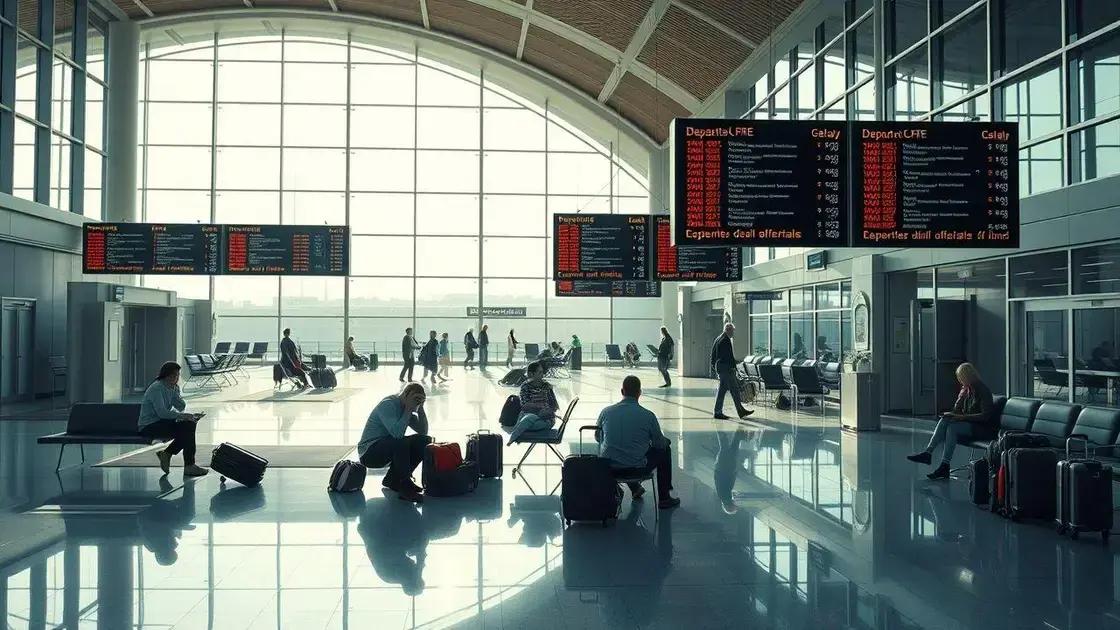Declining demand impacts U.S. international tourism

Anúncios
Declining demand impacts U.S. international tourism due to economic challenges, changing traveler preferences, safety concerns, and the rise of emerging markets, requiring businesses to adapt strategies for recovery.
Declining demand impacts U.S. international tourism in ways that many may not realize. With changing preferences and global circumstances, how does this influence travel experiences for everyone involved?
Anúncios
Current state of U.S. international tourism
The current state of U.S. international tourism reflects significant changes over recent years. With various challenges and opportunities, the landscape has evolved quickly, impacting travelers and the economy alike. Understanding these shifts is key to anticipating future trends.
Recent Trends in International Tourism
In recent years, international tourism in the U.S. has faced a decline due to multiple factors. The pandemic played a major role, limiting travel options for many. However, as restrictions ease, traffic patterns are changing again.
Anúncios
Key Factors Affecting Tourism
- Travel restrictions and health guidelines.
- Economic conditions influencing foreign exchange rates.
- Shifts in consumer preferences towards local experiences.
- Increased competition from other destinations.
This decline is not just about numbers; it’s about the overall experience travelers seek. It’s crucial for businesses to adapt to these new expectations to attract tourists. More travelers are now considering their safety and comfort first.
Moreover, the landscape of international tourism is shifting, with new markets emerging. Places like Southeast Asia are growing in popularity, providing travelers with more options. As we look ahead, it’s essential for U.S. tourism to innovate and enhance the overall visitor experience.
Impact on Local Economies
The impact of declining tourism is felt deeply in local communities. Businesses that rely on foreign visitors often see significant losses. Local economies thrive when tourism flourishes, so understanding the current state helps in devising recovery strategies.
As we move forward, engaging local communities in the tourism dialogue can drive positive change. Enhanced partnerships and marketing efforts can ensure that U.S. tourist destinations remain competitive and attractive.
Factors contributing to declining demand
Understanding the factors contributing to declining demand in U.S. international tourism is vital for the industry. Several elements play a role in shaping travel decisions, and recognizing them can help businesses adapt.
Economic Challenges
One major factor is the current economic landscape. Economic instability can make foreign travel more expensive for potential tourists. When currencies fluctuate, traveling to expensive destinations may not seem appealing. As a result, many choose to stay closer to home.
- High costs of travel due to inflation.
- Foreign exchange rate fluctuations.
- Rising living expenses impacting discretionary spending.
- Global economic uncertainties causing caution among travelers.
In addition to financial hurdles, travelers are also reconsidering their priorities. More are opting for local experiences instead of international trips. A more experience-driven approach means travelers seek meaningful interactions over typical tourist attractions.
Health and Safety Concerns
Health and safety also significantly impact demand. The pandemic has left a lasting impression. Many travelers remain cautious, fearing exposure to health risks while abroad. Even as restrictions ease, the desire for safe travel continues to influence their decisions.
Moreover, the perception of safety at travel destinations is paramount. If a location is perceived as unsafe, travelers will likely look elsewhere. They prioritize destinations with low crime rates and high health standards.
Changes in Traveler Preferences
Finally, shifting traveler preferences further contribute to declining demand. Today’s tourists prioritize unique and authentic experiences. Traditional tourist hotspots may feel less appealing to many. More individuals are interested in exploring off-the-beaten-path locations.
In this evolving market, businesses must shift their strategies to cater to new preferences. Fostering relationships with local communities can create memorable experiences for visitors, which can enhance overall interest and demand.
Economic impacts on local businesses

The economic impacts on local businesses due to declining international tourism are significant. Many communities depend on tourism for their economic stability. When travel numbers fall, local businesses can feel the pinch.
Loss of Revenue
With fewer tourists visiting, businesses that rely on the travel crowd often see a sharp drop in sales. Retailers, restaurants, and hotels particularly suffer. This downturn can lead to layoffs and reduced hours for employees.
- Restaurants may cut menus or reduce staff.
- Retail shops may struggle to maintain inventory.
- Hotel occupancy rates decline, increasing vulnerability.
- Tourist attractions might close or limit operations.
Moreover, the indirect effects can ripple through the economy. Local suppliers that provide goods and services to these businesses also face challenges. Overall, the community’s economic health weakens.
Shifts in Employment Opportunities
As businesses adjust to lower demand, job opportunities can shift dramatically. Many hospitality jobs are seasonal, depending heavily on tourist influxes. When demand declines, these positions vanish quickly, leaving many individuals without work.
Additionally, the need for retraining and transitioning workers may arise. This can create additional strain as residents seek new employment in a shrinking job market.
Innovation and Adaptation
Despite these challenges, some local businesses adapt and innovate. Many pivot to local markets and online services to stay afloat. This can include offering unique experiences that cater to nearby residents rather than tourists.
For example, restaurants might start local delivery services or create special culinary classes. Retailers can emphasize local products that appeal to the community. By making these changes, businesses can mitigate the adverse effects of declining tourism and build a more resilient future.
Shifts in traveler demographics
The shifts in traveler demographics have played a key role in shaping U.S. international tourism. As the world changes, so do the preferences and characteristics of travelers. This evolution impacts how destinations attract and cater to these visitors.
Emerging Markets
Travelers are no longer just from traditional markets. New emerging markets are taking the lead. For instance, tourists from Asia, especially China and India, have become a significant presence in the U.S. These emerging travelers often display unique tastes and expectations, leading to changes in destination marketing.
- Chinese travelers seek luxury shopping experiences.
- Indian tourists often prefer heritage and cultural tours.
- Both groups value flexible travel arrangements and customized experiences.
- Social media influences their travel choices.
Destination marketers need to understand these dynamics to cater to this evolving traveler base effectively. Tailoring services toward these preferences can enhance visitors’ experiences and satisfaction.
Changing Age Groups
Another factor in shifting demographics is the changing age groups of travelers. Millennials and Gen Z are more likely to travel than previous generations. They prioritize experiences over material goods. This younger group often looks for adventure and unique encounters.
In contrast, older travelers tend to favor comfort, convenience, and relaxation. Understanding these differences allows businesses to create tailored experiences for both groups, enhancing their overall satisfaction.
Impact of Social Media
Social media has also transformed how travelers choose their destinations. Many now rely on platforms like Instagram and TikTok for travel inspiration. They tend to prefer visually appealing locations that resonate with their online personas.
This trend has led to increased interest in “Instagrammable” spots and unique accommodations. Businesses must adapt their marketing strategies and highlight these features to attract today’s travelers.
Future outlook and potential recovery strategies
The future outlook for U.S. international tourism looks challenging but not hopeless. As the world begins to recover from recent disruptions, there are several potential recovery strategies that the industry can adopt.
Adapting to New Trends
As travel habits change, the tourism sector must adapt. This includes focusing on experiences that resonate with modern travelers. More tourists are demanding eco-friendly options and authentic cultural interactions. Innovation in service offerings could attract this new wave of visitors.
- Promoting sustainable tourism initiatives.
- Partnering with local communities for unique experiences.
- Creating wellness-focused travel packages.
- Utilizing technology to enhance visitor experiences.
Understanding and aligning with these trends can help attract tourists who prioritize sustainability and authenticity in their travels.
Enhancing Safety Protocols
Another focus area is enhancing safety protocols. Travelers remain cautious, and improving health and safety measures will build trust. Implementing transparent communication about safety practices is key to reassuring potential visitors.
Tourism boards and businesses should prioritize hygiene measures. Regular updates on health guidelines, contactless services, and easy access to medical assistance can help restore confidence among tourists.
Leveraging Technology
Technology will also play a crucial role in future recovery. Utilizing digital marketing strategies and social media can effectively reach a wider audience. Additionally, employing data analytics can provide insights into traveler preferences, allowing for tailored offerings that meet their needs.
By embracing technology, U.S. destinations can enhance their marketing efforts and streamline operations, making it easier for travelers to plan their journeys.
Collaboration and Partnerships
Lastly, collaboration among businesses, government, and communities is essential for overall recovery. By working together, these groups can create comprehensive strategies that promote tourism effectively. Joint marketing campaigns and shared resources can amplify efforts to attract visitors back to the U.S.
FAQ – Questions about the current state of U.S. international tourism
What are the main factors affecting international tourism demand in the U.S.?
Key factors include economic challenges, changing traveler preferences, safety concerns due to health guidelines, and emerging markets.
How can local businesses adapt to declining tourism?
Local businesses can pivot by focusing on local markets, offering unique experiences, and enhancing online services.
What role does technology play in the future of tourism?
Technology helps businesses reach potential travelers more effectively, improve marketing strategies, and streamline operations.
Why is sustainability important for future tourism?
Sustainable tourism appeals to today’s travelers who seek eco-friendly experiences, helping to protect destinations and enhance visitor satisfaction.






